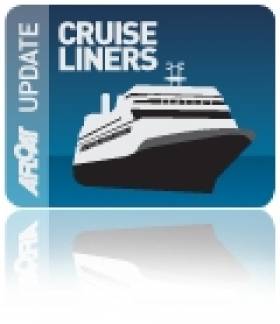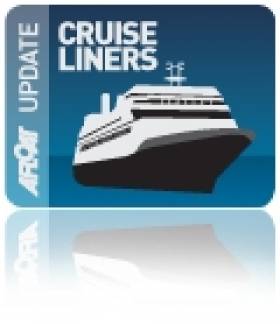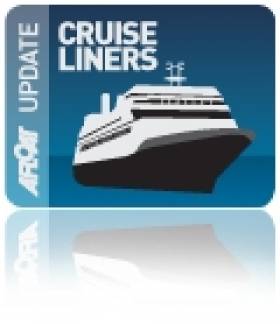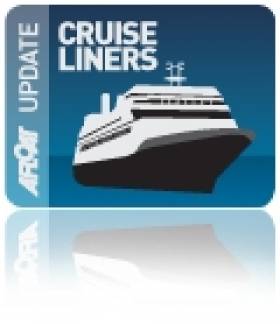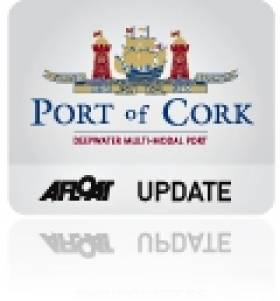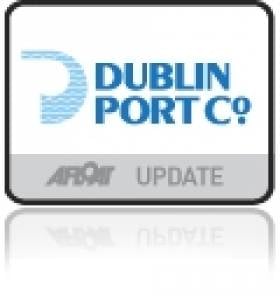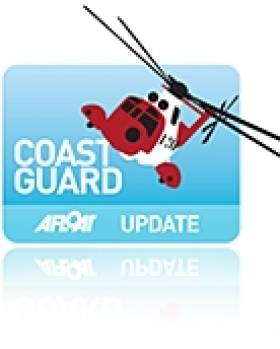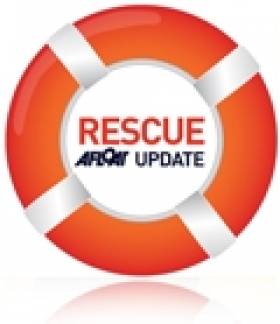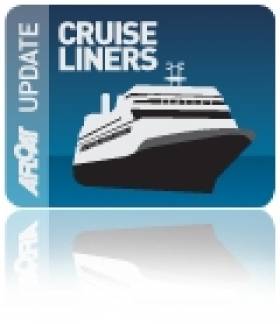Displaying items by tag: Cruise liner
Ten Cruise Liners Due for Dun Laoghaire Harbour, including Queen Mary II
##cruiseliner – 10 cruise ships are expected in Dún Laoghaire in 2013 bringing an esitmated 10,000 visitors to the east coast town according to Dun Laoghaire Harbour Company. The world famous Queen Mary II will be one of the first arrivals in to Dublin Bay and Dún Laoghaire on May 16th 2013. Cunard Line's flagship Queen Mary 2 previously docked at Cobh in 2011. The 148,528 tonnes giant liner cost €549m and she is the only true 'liner' operating in the world today as she on occasions provides scheduled trans-Atlantic sailings between Southampton and New York. More on the Queen Mary II.
Luxury Cruise Liner 'Lirica' Makes Maiden Call to Dublin Port
#cruiseliner – A $250million luxury cruise liner, the 59,000 tonne, 251 metre "MSC Lirica" with almost 3,000 passengers and crew on board sailed into Dublin Port at 7am this morning on her maiden call to Ireland. The MSC Lirica, carrying passengers mainly from Germany, Austria, Spain, France and Italy, boasts an array of luxurious facilities including swimming pools, health spa, Turkish baths, nightclub and cabaret, theatre, casino, bars, restaurants and shopping.
Her arrival marks the first of two cruise calls to Dublin secured by Dublin Port Company with leading cruise company MSC Cruises. MSC Lirica will return to Dublin on 25th August as part of Dublin Port Company's 90-strong cruise liner schedule for 2012 and ongoing efforts to attract this valuable tourism business to the city. In addition, Dublin Port Company will welcome two further new cruise calls from MSC Cruises with the arrival of the $547million, 294 metre "MSC Magnifica" cruise ship already scheduled to make her maiden call to Dublin Port in May 2013.
The arrival of these luxury cruise ships generates a significant boost to Dublin of between €35 and €50 million for the local economy, bringing over 100,000 high spend passengers and crew to the city and surrounding areas' shops, attractions and eateries each year.
The cruise sector has become a hugely important part of the city's tourism product since Dublin Port Company first targeted this trade in the mid 1990s. It is estimated that cruise liners have contributed over €350 million to the city in the last decade alone so Dublin Port Company is pleased to have played its role in attracting and developing this growing business for the city.
Dublin Port Company's Masterplan 2012-2040 identified the construction of a new cruise facility adjacent to the east of the East Link Bridge as one of a number of major projects for development within the next five years at a total investment of €110 million. The dedicated cruise terminal will enable Dublin Port to accommodate growing cruise passenger numbers and larger vessels within easy reach of the Luas and city centre.
To progress the project, Dublin Port Company is preparing to launch "Cruise Dublin", a joint initiative with Dublin City Council and Dublin Chamber of Commerce to further the cruise tourism trade in Dublin, as well as the findings of a study on how a suitable cruise terminal can be provided in Dublin with a view to having the new cruise terminal in place by 2015.
Mr. Eamonn O'Reilly, Chief Executive, Dublin Port Company said, "Dublin Port Company is delighted to welcome MSC Lirica on her maiden call to Ireland as one of 90 luxury cruise liners scheduled to call in Dublin this year. We're in the heart of Dublin and developing a strong reputation as the go-to city for high end cruise calls thanks to our proximity to Dublin's shops, eateries and tourist attractions, as well as Dublin airport. The addition of MSC Cruises to Dublin Port's cruise liner schedule is testament to the fantastic offering here at Ireland's largest gateway for cruise visitors. We're already working to increase this valuable trade for Dublin in 2013 and the work of Cruise Dublin will help us to achieve this in the best possible way forward for the city."
Naoise Ó Muirí, Lord Mayor of Dublin, said, "It's fantastic to see Dublin developing a reputation as a world-class cruise tourism destination year on year. I congratulate Dublin Port Company on its efforts to secure the addition of MSC Cruises as part of its busy cruise schedule this year. The passengers of MSC Lirica can be assured of a warm welcome in Dublin, while our city's retailers, eateries and attractions will benefit immensely from the welcome boost to the local economy brought by these luxury vessels."
Seven Seas Voyager Departs Cork Harbour
#cruiseliners – The Seven Seas Voyager cruise liner departed Cork harbour last night after treating 708 well-heeled passengers to the sights of Cobh and the surrounding harbour area. This European cruise liner has an overall lengh of 670–ft and a beam of 94.5 ft. She has a top speed of 20 knots and 447 crew.
New Dock for Cruise Liner Passengers in Dun Laoghaire
#CRUISE LINER – Dun Laoghaire Rathdown County Council and Dun Laoghaire Harbour Company have announced the completion of a new Tender Facility to accommodate large cruise liners in Dun Laoghaire harbour. The new facility will also have a range of other local uses. The facility was funded by both organisations.
In addition to the arrival of the tender facility, Dun Laoghaire is preparing to welcome the first in a series of Cruise ships for 2012 on the 24th April. This Cruise call marks the 1st phase of cruise calls to Dun Laoghaire this summer which promises to provide a significant economic boost to the area.
According to Gerry Dunne, the CEO Dun Laoghaire Harbour Company and Owen Keegan, County Manager of DLR County Council the arrival of the new facility is very positive in that it provides great access for the tender boats carrying passengers from large Cruise Ships that dock outside the harbour in the bay.
Large Cruise ships that heretofore could not bring visitors to Dublin can now avail of this facility to land thousands of new tourists into Ireland. The public will also benefit from the facility as it can be used for training purposes and the operation of Boat Tours around Dublin Bay and to Dalkey Island.
More Cruise Liner Success for Port of Cork
The Port of Cork has scooped another two cruise awards for 2011. The awards for 'Best Shore side Welcome' and 'Best Tour Guides' were announced at Seatrade Miami, the global annual cruise shipping conference. This is the second year in a row that the Port has won such prestigious awards for their cruise business.
This announcement comes as the Port of Cork prepares to start their 2012 cruise season next week with the arrival of MV Balmoral and MV Marco Polo. In total up to 60 cruise liners will visit the port between April and November bringing over 100,000 passengers and crew to the region.
Receiving these awards, Chairman of the Port of Cork Mr Dermot O'Mahoney said: 'Receiving these global cruise awards shows the dedication and efforts made by the Port of Cork to ensure new and existing cruise companies continue to call to Cork. As well as investing in cruise facilities, the Port is also proactive in marketing the port and the region directly to the cruise companies.'
The winners of 'Cruise Insight' Annual Awards (formerly Dream World Cruise Awards) are based on surveys that are collected and analysed from Cruise Line Executives from all of the major cruise companies. The awards, launched in 1993, announce the ports and destinations that have provided outstanding services to ships, passengers and crew. The geographical mix of large and small ports receiving awards from Dubai, Far East, the Caribbean, Mediterranean, Baltic and Americas, reflected the global nature of the business. In 2011 there were a total of 87 worldwide winners, with 22 receiving more than one award, such as the Port of Cork.
Brendan Keating, Chief Executive of the Port of Cork also commented on the cruise awards saying: 'We as a port are very satisfied to have received these cruise awards two years in a row and we hope to continue our success next year. 2012 will be a another busy year for the cruise business in Cork, with 60 liners calling, of which three are operating part turnaround calls and ten liners are maiden visits to the port.'
He continued: 'While the port puts in a huge effort to bring the liners to Cork, the business would not work without the relationship and continued joint efforts of the Tour operators, Ship agents, Bus companies, Irish rail, local tourism groups and Cobh & Harbour Chamber, as well as the great tourist attractions on offer within the region, to help make the cruise business what it is today in Cork.
'2012 will also mark the 100th anniversary of the sinking of RMS Titanic which will attract many visitors to the town of Cobh. Both MV Balmoral and MV Marco Polo are carrying out themed Titanic cruises next week to commemorate the anniversary and Titanic 100 will also host a number of exciting events throughout the month in Cobh town.'
The Port of Cork is home to Ireland's only dedicated cruise berth in Cobh
Dublin Port Ferry Passenger Numbers fell by 5.6% to 1.7m
#PORTS – Dublin Port Company today published trade statistics for 2011. Total throughput in 2011 was broadly in line with 2010, down by only 0.1% to 28.1m tonnes. Within this, however, exports continued to grow and were up 2.8% in the year at 11.5m tonnes.
2011 trade statistics summary:
Total throughput – 28.1m tonnes, down 0.1%
Exports – 11.5m tonnes up 2.8%
Imports – 16.6m tonnes down 2.0%
Bulk Liquid – 3.6m tonnes, down 4.7%
Bulk Solid – 1.6m tonnes, up 10.8%
Unitised trade now accounts for 81% of Dublin Port's business. During 2011, Ro-Ro freight volumes were virtually unchanged at 725,000 units. In contrast, Lo-Lo volumes fell by 5.1% to 526,000 TEU.
Ferry passenger numbers fell by 5.6% to 1.7m. This follows a record year in 2010 when numbers were boosted by the impact of weather and ash clouds. Compared to 2009, passenger numbers were up 11.1%.
With 1.7m ferry passengers moving through the port, Dublin Port is behind only Dublin Airport and Cork Airport as a national tourism gateway.
The cruise liner side of Dublin Port's business saw a 7.5% increase in cruise passengers. During 2011, 87 cruise ships brought over 135,000 passengers and crew to Dublin.
Commenting on the trade figures, Eamonn O'Reilly, Dublin Port Company's Chief Executive said:
"Trade levels at Dublin Port were steady in 2011 which is a robust performance given the large (6.1%) increase in the port's volumes in the previous year.
"Whereas export volumes have continued to grow and are now 0.5m tonnes higher than they were in 2007, the poor performance of the domestic economy has resulted in a continued decline in imports. These are now 3.4m tonnes lower than they were in 2007.
"Notwithstanding the poor performance of the economy we are continuing to plan for the future and will shortly be launching our Masterplan 2012 to 2040. Dublin remains the largest and most important port on the island and our Masterplan is intended to ensure we continue to provide vital port capacity particularly as the economy returns to growth in coming years.
"With all the difficulties in the economy we are still only 9% behind where we were at the peak in 2007 and we believe that any pick-up in domestic demand will quickly translate into growth in import volumes. The Masterplan will ensure we stay ahead of future growth in demand for decades to come".
Italian Coastguard to Deliver Keynote at Dublin Conference
#COASTGUARD - Representaives of Italy's coastguard will give an account of its handling of the Costa Concordia tragedy at an international conference in Dublin next month, The Irish Times reports.
The Italian coastguard has been invited to deliver the keynote address at Search and Rescue 2012, which is being hosted in Ireland for the first time.
It is expected that this address will include a detailed account of the sinking of the cruise liner Costa Concordia last month.
At least 17 people have died and 12 are still missing after the ship ran aground on the western Italian coast. One Irish couple were among the thousands rescued from the stricken vessel.
Meanwhile, attendees at the conference - which is being hosted in the year of Ireland's charing of the EU coastguard network - will also witness demonstrations of the Irish Coast Guard's rescue helicopter fleet at Weston Airport in Leixlip.
As previously reported on Afloat.ie, Irish Coast Guard director Chris Reynolds has been charged with preparing the grounds for a permanent secretariat to be run by EU coastguard officers.
Irish Couple Speak of 'Titanic' Experience on Capsized Cruise Liner
#NEWS UPDATE - The Irish couple rescued from the stricken cruise liner off the Italian coast have spoken of their joy to be back home safe and sound.
Séamus Moore (52) and his wife Carol (50) from Clonmel were greeted by their three children at Dublin Airport yesterday, just two days after the Costa Concordia struck a sandbank and capsized off Tuscany.
“It was a difficult experience but at the end of the day it worked out very well for most people," Carol told The Irish Times. "It’s really, really a relief to be home.”
Commenting on the events of Friday night, Séamus likened their experiences on the sinking cruise ship to the film Titanic.
“When we were sitting on the side of the ship I said to her ‘now we know what Leonardo DiCaprio and Kate Winslett felt like’ and she said ‘well at least Kate lived’."
As the boat listed, it also struck Séamus that while "everything was crashing one way, then the next, the one thing I did notice is that the piano player kept playing."
The couple were removed from the ship by lifeboat in the early hours of Saturday and looked after by the staff at the Irish Embassy in Rome before their return.
They were among some 4,000 passengers on the cruise ship, most of whom were rescued within hours of the incident. Six people are confirmed dead following the disaster, with more than 60 injured and 16 people still missing.
The captain of the 114,500-tonne vessel was arrested on Saturday accused of manslaughter and of abandoning ship before all passengers and crew had been evaculated.
The Irish Times has more on the story HERE.
Divers Recovered from Lusitania Site After Boat Troubles
The Irish Times reports that the Courtmacsherry RNLI lifeboat went to the aid of divers at the wreck of the Lusitania yesterday.
The divers had been operating at the wreck site when their boat developed mechanical issues.
The lifeboat responded immediately in windy conditions and removed the crew to safety, towing the boat to Courtmacsherry.
As previously reported on Afloat.ie, divers led by the wreck's American owner hope to uncover the last big secrets of the stricken cruise liner, which was torpedoed by a German U-boat during the First World War.
Port of Cork Awarded Two Top Cruise Liner Awards
The Port of Cork has won first place for 'Best Destination Experience (Organised)' in the world and 2nd place for 'Best Port Welcome' after attending the largest annual cruise conference 'Cruise Shipping Miami' where the 15th Annual "Dream World Cruise Destinations" 2010 Awards were announced. This achievement highlights the outstanding team effort and commitment by the Port of Cork to deliver an excellent service to the visiting cruise lines and their passengers when in Cork. Ireland Inc received a Commendation as a "Destination where the Quality and Professionalism of Tour Guides is considered outstanding".
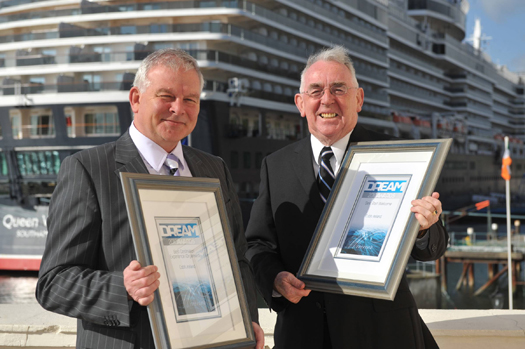
Port of Cork CEO Brendan Keating (left) and Chairman Dermot O'Mahoney with the awards
Since the early 1990's the Port of Cork has been welcoming cruise liners to Cork Harbour and today an average of 54 cruise liners call each year bringing over 100,000 passengers and crew to the region. The Port of Cork has invested heavily in this business and has ambitious plans to grow the business to 75 calls over the next five years. Receiving these world awards shows the enormous effort by the Port of Cork to ensure new and existing cruise companies continue to call to Cork. The Port of Cork can provide excellent deep water facilities for liners in Cobh and Ringaskiddy, making it an attractive port of call for the larger liners as well as smaller liners.
The winners of 'Dream World Cruise Destinations' Annual Awards are based on surveys that are collected and analyzed from Cruise Line Executives from all of the major cruise companies. The awards, launched in 1993, announce the ports and destinations that have provided outstanding services to ships, passengers and crew. The geographical mix of large and small ports receiving awards from Dubai, Far East, the Caribbean, Mediterranean, Baltic and Americas, reflected the global nature of the business.
Speaking about the awards, Captain Michael McCarthy Commercial Manager at the Port of Cork said: "The Port of Cork is very grateful to receive these world awards. It is such an achievement not only for the Port but Cork as a region. We are fortunate to have excellent relationships with tourism providers, tour operators, Irish Rail and local tourism groups to be able to win these awards. Considerable effort goes into welcoming these liners when in Cork and we would like to share these awards with everyone who works with us on making this business work for the region. The awards will be used as a benchmark to drive growth in the cruise business, review product delivery and continue to review the berthing of small, medium and mega vessels."
He continued: "We are committed to growing the cruise liner business in Cork and winning these awards gives us the confidence to make this happen. The cruise liner business is worth an average of €8 million per annum directly to the Cork region and many businesses in the region can benefit from these vessels. The Port of Cork aims to continually work with City, County and Local Town Councils, tour operators, tourism service providers and many other local bodies to succeed in our ambitious plans for growth."
"The poignancy of the arrival of our first cruise vessel for 2011, the MV Queen Victoria, is its berthing on the 99th anniversary of the departing of the Titanic from Cobh on the 11th April 1912. Cobh's association with the Titanic will be commemorated during 2012 and already travels writers and historic groups are visiting Cobh to make its association."
In 2011, 54 cruise ships are scheduled to call to the Port of Cork facilities including the maiden call of the brand new MV Queen Elizabeth and the largest liner to call to an Irish port, MV Independence of the Seas. Over 100,000 passengers and crew will visit the Cork region during the liner season.
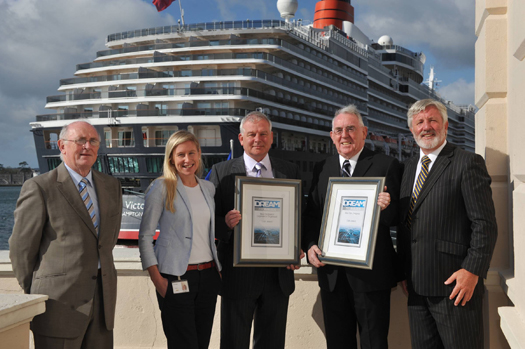
Captain Pat Farnan, Sara Dymond, Brendan Keating, Dermot O'Mahoney and Captain Mick McCarthy with the second award for the Port of Cork


























